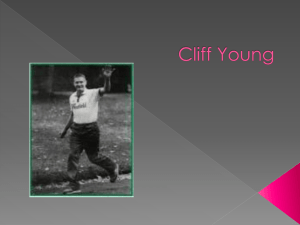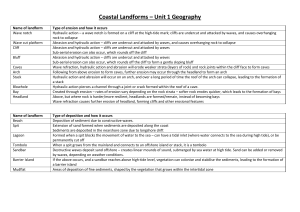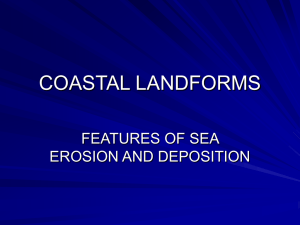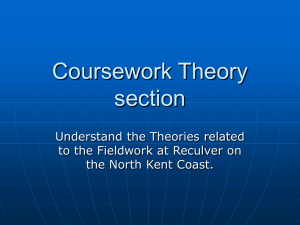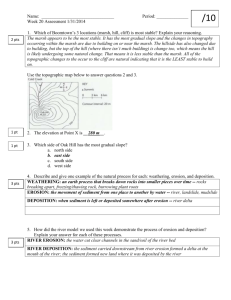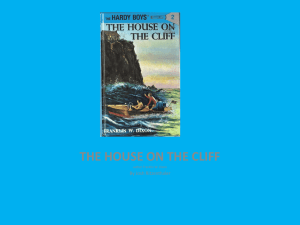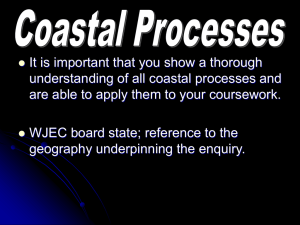MS Word file
advertisement
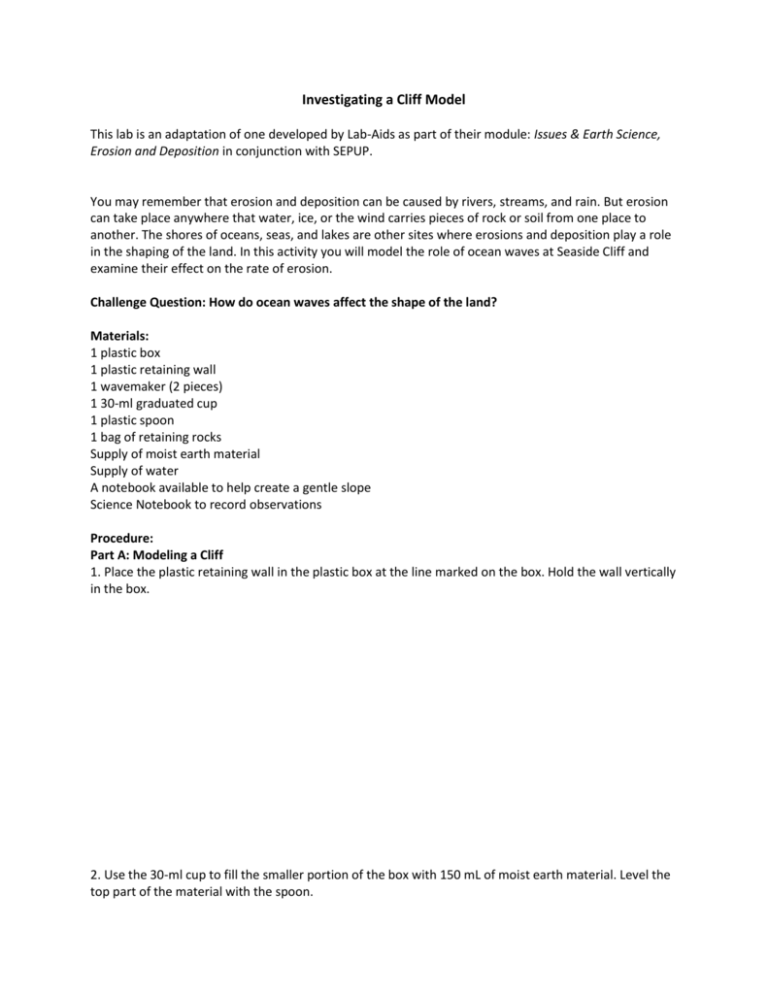
Investigating a Cliff Model This lab is an adaptation of one developed by Lab-Aids as part of their module: Issues & Earth Science, Erosion and Deposition in conjunction with SEPUP. You may remember that erosion and deposition can be caused by rivers, streams, and rain. But erosion can take place anywhere that water, ice, or the wind carries pieces of rock or soil from one place to another. The shores of oceans, seas, and lakes are other sites where erosions and deposition play a role in the shaping of the land. In this activity you will model the role of ocean waves at Seaside Cliff and examine their effect on the rate of erosion. Challenge Question: How do ocean waves affect the shape of the land? Materials: 1 plastic box 1 plastic retaining wall 1 wavemaker (2 pieces) 1 30-ml graduated cup 1 plastic spoon 1 bag of retaining rocks Supply of moist earth material Supply of water A notebook available to help create a gentle slope Science Notebook to record observations Procedure: Part A: Modeling a Cliff 1. Place the plastic retaining wall in the plastic box at the line marked on the box. Hold the wall vertically in the box. 2. Use the 30-ml cup to fill the smaller portion of the box with 150 mL of moist earth material. Level the top part of the material with the spoon. 3. Place the sand-filled end of the box on a notebook. This will create a gentle slope. 4. While holding the retaining wall in place, gently pour water into the edge of the box opposite the earth material until it just touches the bottom of the cliff. 5. Complete the cliff model by carefully removing the retaining wall. Do this by slowly lifting the wall straight up out of the box. Record your sketch and observations in your science notebook. 6. Place the slotted part of the wave-maker on the side opposite the model cliff .Insert the other piece of the wavemaker into the slot, as shown below. 7. At the rate of 1 wave per 3 seconds, move the wavemaker back and forth along the bottom of the box 5 times. Record your observations in your science notebook. 8. Make 5 more waves and record your observations in your science notebook. Make 2 more sets of 5 waves and record your observations. 9. Observe the bottom of the container and record any additional observations in your science notebook. 10. Place the retaining wall back in the plastic box and use it to push the earth material back into the box. Carefully drain out any remaining water in the box. Part B: Slowing Down Erosion 11. The bag of retaining rocks models the structures that are sometimes used to protect cliffs from the power of waves. Design and investigation to determine the effect of the retaining rocks on the erosion of the cliff model. While you are designing the investigation, think about the following questions: What is the purpose of the investigation? What will you observe or test? What materials will you need to conduct your investigation? How will you record your observations? How will you use the results to make a conclusion? 12. Obtain your teacher’s approval of your investigation. 13. Conduct your investigation and record your results. Analysis 1. What did the waves do to the cliff model> Explain in terms of erosion and deposition. 2. What was the effect of the retaining rocks on the model cliff? 3. a. What kind of landform was created at the bottom of the model cliff? b. What earth process was involved? 4. Granite on a mountaintop is likely to erode differently than granite on a sea cliff> Why do you think this is true? Extension Design and conduct an investigation of the model cliff that compares the erosion in an area that has high and powerful waves to the erosion in a calmer are with less powerful waves. Science Notebook Journal Entry Cliff Model at set up: Sketch and record observations. (Step 5 of procedure) Observations after first set of waves (Step 7) Observations after second set of 5 waves (Step 8) Observations after third set of wave (Step 8) Observations after fourth set of waves (Step 8) Observations of bottom of container (Step 9) Place Analysis Questions Answers on the back.
